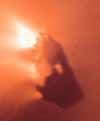
| Bad Astronomy |
|
|
|
BA Blog
|
|
Q & BA
|
|
Bulletin Board
|
| Media |
|
|
|
Bitesize Astronomy
|
|
Bad Astro Store
|
|
Mad Science
|
|
Fun Stuff
|
| Site Info |
|
|
|
Links
|
| RELATED SITES |
| - Universe Today |
| - APOD |
| - The Nine Planets |
| - Mystery Investigators |
| - Slacker Astronomy |
| - Skepticality |
Buy My Stuff

Keep Bad Astronomy close to your heart, and help make me
filthy rich. Hey, it's either this or one of those really
irritating PayPal donation buttons here.
James McCanney's Nonsense: Dirty Snowballs
McCanney's Claim #1: Comets are not dirty iceballs, but hot, rocky bodies with no water.
The core claim McCanney makes is that comets are not frozen balls of dirt and ice, as mainstream science would have you think. This is a striking claim. Noted astronomer Fred Whipple coined the phrase "dirty snowballs" to describe comets, meaning that they are dust, rock, and gravel all bound together in a matrix of ice (the ice itself has all sorts of things in it like water and ammonia). This has been the working paradigm for decades. If McCanney is right, and comets are hot and have no water, this would throw cometary science on its head.
Well, McCanney is wrong. You'd better get used to reading that sentence. The way to tell is by looking at the predictions made by mainstream science versus McCanney. He says comets are hot and dry. Mainstream science says they are cold and icy. The obvious questions is, is there some way to tell? Is there some way to measure a comet's temperature?
Yes, there is! You use a spectroscope. This is a device that breaks light up into its constituent "colors", like a prism which breaks up white light into the rainbow of colors. This rainbow is called a spectrum (plural = spectra).
The spectrum from an object depends on many things, but mostly on its temperature and what its made of. For example, the Sun has a spectrum that looks very much like that from a ball of hydrogen gas heated to about 6000 Celsius (about 10,000 Fahrenheit)-- because that's just what it is! A cooler star has a slightly different spectrum, as does a hotter one. An object's spectrum is like its fingerprint, and with it you can identify many of its characteristics.
Astronomers have been taking spectroscopic measurements of comets for decades. The result? Comets are cold. In fact, the temperatures measured are consistent with them being balls of frozen gases. If they were hot, the spectra would be very different, and this simply isn't seen (as indicated in the link above).
Okay, so they're cold. That's half of McCanney's claim shown wrong right away! But are comets dry? In principle, this should be easy to prove wrong or right. Just look for water on a comet!
 In
his book ("Planet-X Comets & Earth Changes", pages 2-7), McCanney
says that he predicted comets are dry, and have no water ice. He then claims
his theory was vindicated when the space probe
Giotto arrived at Comet Halley, and found it to be very dark, indicating
it had no water ice (ice is bright). But surprise! McCanney is wrong again.
In reality,
Giotto detected lots of water, finding that 80% of the material emitted
by Halley was composed of water! Just because something is dark doesn't
mean it's dry. Hasn't McCanney ever been anywhere where it snows? Snow or ice
is only white and pristine while it falls. After it sits on the ground it gets
mixed up with dirt, turning brown (or black in a city). That's why they're called
"dirty snowballs".
In
his book ("Planet-X Comets & Earth Changes", pages 2-7), McCanney
says that he predicted comets are dry, and have no water ice. He then claims
his theory was vindicated when the space probe
Giotto arrived at Comet Halley, and found it to be very dark, indicating
it had no water ice (ice is bright). But surprise! McCanney is wrong again.
In reality,
Giotto detected lots of water, finding that 80% of the material emitted
by Halley was composed of water! Just because something is dark doesn't
mean it's dry. Hasn't McCanney ever been anywhere where it snows? Snow or ice
is only white and pristine while it falls. After it sits on the ground it gets
mixed up with dirt, turning brown (or black in a city). That's why they're called
"dirty snowballs".
And it's not just Comet Halley that has water ice; astronomers see lots of water ice in comets. His claim that comets are dry is grossly misleading, to put it delicately. And the fact that he doesn't mention that comets have been seen to have ice almost all the time is also grossly (I would even say suspiciously) misleading. He harangues on this over and over in his book and in radio interviews. But he's dead wrong. Comets have water, and lots of it, and there is lots of proof of it. Tons, in fact, in every comet!
Let me be clear here: the claims that comets are hot and dry are crucial to his theory. Without them, his theory is dead. Guess what? Comets aren't hot and dry. His theory is dead.
Conclusion: Comets are cold balls of ice, not hot and dry. McCanney is wrong.
|
|
|
|